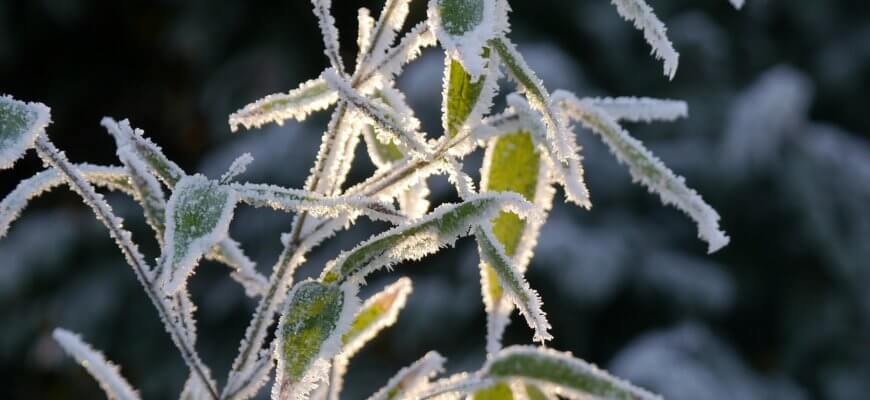The theme of ice gave me a hard time finding a topic to write about. Being the botanist in our group, of course I wanted to write about plants, which made me think about the challenges plants are facing with ice or snow. In areas of constant low temperature, vegetation is generally pretty scarce. Of course there are always some especially-adapted weirdo plants, capable of surviving in a harsh environment like snowy and icy region. Often we are writing about examples like that. Today though I want to ask and try to answer a rather simple question. ‚Normal‘ (boring?) plants in our gardens or the park – can they survive freezing? Are there frost-resistant plants? And if yes, how do they cope with their tissues freezing? And – of course – are we able to learn something from their strategies in terms of Biomimetics?
How do plants do it?
Plants are often given a hard time by their environment. The sun is shining pretty strong – they are burning because they cannot move into the shade. A predator comes to feed on them – they are eaten because they cannot flee or hide. And now comes winter and temperatures are dropping and plants cannot crawl into their burrow, hibernate or move to a warmer region. If they want to survive, they have to figure out a way to resist freezing. How do they manage? I would like to introduce a very clever strategy from herbaceous plants, described by McCully et al. (2004) in a highly interesting and easy to understand publication, which I found pretty fascinating to read.
Herbaceous plants are missing a woody stem, so their soft tissues are quite exposed to the outer environmental conditions and vulnerable towards freezing. Let’s imagine a condition with frosty periods (at night) and a rather warm climate during the day (above 0°C). When plant petioles (the leaf stalks) are frozen, the plants can be observed to droop (meaning that the plant is ‚hanging downwards‘), which is a sign of loss of turgor (internal pressure of a cell, pushing against the cell wall). In the process of thawing, they regain their upright position – the turgor is recovering. As freezing is taking place, water is lost from parenchyma cells (a type of ‚ground tissue‘ making up most of the soft parts of plants) and flows into the extracellular space. That is what causes the turgor to drop and the plant to loose stiffness. The water in the extracellular space is freezing under the epidermal (the outer) tissue layer. Both the shrunken parenchyma tissue and the epidermal tissue are intact – just with a massive block of ice in the middle. The two layers stay in contact via three anchorage points, fixing the epidermal layer to the parenchyma tissue and holding it in place (and preventing it from tearing off).This structure is visualized in this schematic drawing of a cross-section of a frozen petiole (Fig.1). The parenchyma tissue is shown in green, the epidermal layer in black and the ice in white. The red circles are highlighting the anchorage points. As the plant s thawing and the extracellular ice melts, the water is reabsorbed by the parenchyma cells and the petiole returns to its original shape.

Schematic drawing of a frozen petiole (after Prillieux 1869/ McCully et al. 2004)
That’s interesting… but what does it mean?
It means, that plants are capable of managing the formation of ice crystals to protect its cells from freezing and bursting and holding its tissues into shape, to prevent tearing. Also in the cited publication, the authors are actually talking about ‚managing extracellular ice‘ which I find a pretty appropriate term!
So besides being amazing, how can we take inspiration from the plants way of dealing with frost? In the collaborative research centre TRR141, a project is dealing with investigating plant tissues as natural graded porous material which can deal with repetitive freezing and thawing cycles without damage. Besides managing the area of ice crystal formation (taking into account the physical behaviour of water) other relevant aspects of ice in plants are for example: Do some cell layers act as a natural isolation? How is moisture transported across tissues? (How) Are some cell types or layers being actually frost-resistant and not only capable to lose water? Goal of this project is to transfer mass and heat transport properties into a continuum-mechanical model (what?). This means: via understanding what happens inside the plant when it freezes and modelling the underlying physics, existing porous construction materials are to be optimized to be adapted to specific conditions (changing temperatures, humidity, etc.).
I hope this insight gave you a different perspective on frozen plants which you might encounter more frequently in the following months and into its potential for material science.
Have nice and icy winter !
PS: Can you maybe find parallels in the described technique of plants to the one of the wood frog when it comes to freezing? Check Anjas article from last week and decide for yourself which one is your favourite anti-freezing strategy 🙂
References
- M.E. McCully, M.J. Canny and C.X. Huang (2004) The Managment of Extracellular Ice by Petioles of Frost-resistant herbaceous plants. Annals of Botany 94: 665-674.
- http://www.trr141.de/index.php/research-areas-2/research-areas/



